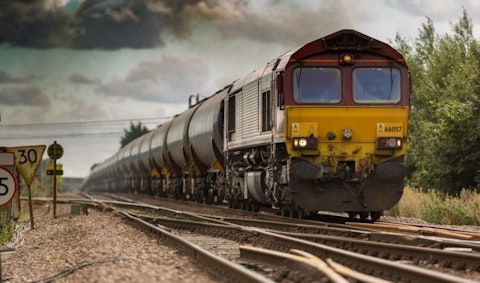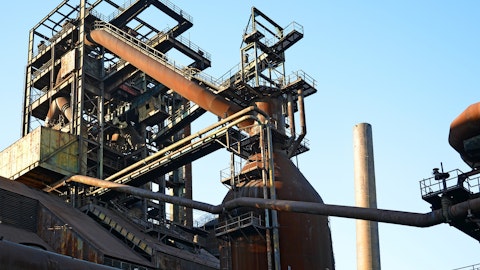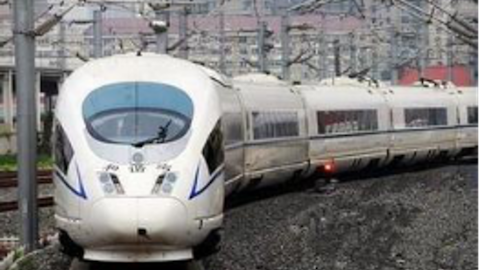Union Pacific Corporation (NYSE:UNP) Q2 2023 Earnings Call Transcript July 26, 2023
Union Pacific Corporation beats earnings expectations. Reported EPS is $2.93, expectations were $2.75.
Operator: Greetings and welcome to the Union Pacific Second Quarter Earnings Call. [Operator Instructions] As a reminder, this conference is being recorded, and the slides for today’s presentation are available on Union Pacific’s website. At this time, it’s now my pleasure to introduce your host, Mr. Lance Fritz, Chairman, President and CEO for Union Pacific. Mr. Fritz, you may begin.
Lance Fritz : Thank you, Rob, and good morning and welcome to Union Pacific’s second quarter earnings conference call. With me today in Omaha are Kenny Rocker, Executive Vice President of Marketing and Sales; Eric Gehringer, Executive Vice President of Operations; and Jennifer Hamann, our Chief Financial Officer. We’re also joined by our newly elected Independent Chair of the Board of Directors, Mike McCarthy, who will take a couple of minutes to address the announcements we made this morning regarding my successor and our Board. Mike, the floor is yours.
Michael McCarthy : Thanks, Lance. This morning, the Board of Directors announced that Jim Vena will be appointed the next Chief Executive Officer of Union Pacific. The Board has also appointed Jim to the Board of Directors. Jim brings a strong rail operations background at Union Pacific with over 40 years of experience. This includes two successful years as our Chief Operating Officer from 2019 to 2020. After a comprehensive search process, it was clear Jim’s track record of operating excellence was unparalleled and he was the right candidate for the job. Jim will start as CEO on August 14, and we look forward to welcoming him back to Union Pacific. The Board also announced that Beth Whited will be appointed President of Union Pacific.
Beth has over 35 years of experience at our company and has held leadership roles across multiple departments. Recently, she has led our strategy, sustainability and workforce resource teams with great success. Going forward, the operations, finance, marketing and sales, supply chain and technology functions will report directly to Vena. Whited will report to Vena, and her responsibilities will include the strategy, workforce resources, sustainability, law, corporate relations and government affairs functions. In addition to these management changes, the Board is appointing two new Board members: Doyle Simons, former President and Chief Executive Officer of Weyerhaeuser; and John Wiehoff, former Chairman, President and CEO of C.H. Robinson.
Both bring to our Board a wealth of skill sets, including operational expertise from leading large industrial public companies. As Lance indicated, as part of these changes, we are adopting a corporate governance best practice by splitting the role of company CEO and Board Chair. With my election, the Independent Chair, Director, Sheri Edison, will take over leadership of the Corporate Governance, Nominating and Sustainability Committee. In addition, the Board has created a new committee, Safety and Service Quality, which will have responsibility to review, evaluate and monitor compliance with safety programs and provide oversight of the company’s service performance. Director Jane Lute will lead this committee. The Board is very pleased to make these announcements today, which represent a continued commitment to Board refreshment to ensure that we have the right mix of skills and experience to oversee the company.
We are confident that these new appointments set Union Pacific up for long-term value creation. Before I turn it back over to Lance, I would like to thank him for his leadership these past eight years. His accomplishments are many. And over the next few weeks, we will properly celebrate them. Most importantly, though, his leadership has set our company up for great success for the years to come. Thank you, Lance. And I’ll turn it back over to you.
Lance Fritz : Thanks, Mike. We appreciate your leadership throughout the process. And I’m pleased to welcome back Jim to Union Pacific, and I’m confident that the company has the right leaders to advance the hard work that’s underway. Now let’s turn to the business of the call and second quarter results. This morning, Union Pacific reported 2023 second quarter net income of $1.6 billion or $2.57 per share. This compares to 2022 second quarter net income of $1.8 billion or $2.93 per share. Our second quarter operating ratio of 63% was up 280 basis points versus 2022 primarily driven by lower revenue, inflationary pressures and the previously disclosed onetime ratification bonus payment. Throughout the quarter, we provided our customers with a more consistent and reliable service product while generally meeting the demand that was available to us.
Eric will discuss in more detail the progress we’ve made, but the bottom line is that the actions we’ve taken to strengthen our crew resources are improving the railroad. We also acted during the quarter to increase the efficiency of our network by rightsizing our locomotive fleet using crews more efficiently and making sequential improvements in train length. We finished the quarter with our resources better aligned with current volumes. As you’ll hear from Kenny, while several of our markets showed growth, consumer-facing markets remained soft and drove the volume decline. However, the strength of our business development efforts enabled us to mitigate the macro impact and outperform our peers. So let me turn it over to Kenny to provide more color on the business environment.
Kenny Rocker: Thank you, Lance, and good morning. For the second quarter, volume was down 2% driven by weak market conditions in our premium and bulk business groups. Freight revenue declined 5% driven by lower fuel surcharges and a [2% decrease in volume. However, we generated solid core pricing gains in the quarter to help offset some of those challenges]. Let’s take a closer look at each of these business groups. Starting with bulk. Revenue for the quarter was down 3% compared to last year, driven by a 2% decrease in average revenue per car due to lower fuel surcharges and a 1% decline in volume. Grain and grain products volume was up 1% due to increased demand and business wins for renewable diesel feedstocks, coupled with strong shipments of domestic grain.
A soft U.S. export grain market partially offset these gains. Fertilizer carloads decreased by 9% in the quarter due to an outage at a customer facility that reduced export potash shipments. Food and refrigerated volume was down 8% due to reduced beer imports early in the quarter, but those shipments eventually improved by June. In addition, drought conditions from the prior growing season negatively impacted both fresh and can shipments. And lastly, coal and renewables volume was flat year-over-year. Low natural gas prices and reduced electricity demand from mild weather negatively impacted shipments, but that was offset by a favorable comparison to 2022. With our service improvements and additional resources, we are currently meeting available demand.
Moving on to industrial. Industrial revenue was flat for the quarter driven by a 1% improvement in volume, offset by a 1% decline in average revenue per car. Core pricing gains in the quarter were offset by lower fuel surcharges and a negative mix in volume. Industrial chemicals and plastics volume was up 2% year-over-year, driven by increased plastic shipments, partially offset by lower industrial chemical shipments due to challenged industrial production levels and reduced housing demand. Metals and minerals volumes continue to deliver year-over-year growth. Volume was up 2% compared to last year primarily driven by growth in construction materials and increased frac sand shipments along with new business development wins. Forest products volume declined 13% year-over-year driven by challenging market conditions in housing and repair and remodel, coupled with lower corrugated box demand.
However, energy and specialized shipments were up 2% versus last year driven by strong business development and increased demand for LPG and petroleum products. Turning to premium. Revenue for the quarter was down 11% on a 4% decrease in volume compared to last year. Average revenue per car decreased by 8%, reflecting lower fuel surcharge revenues. Automotive volumes were positively driven by continued strength in OEM production and inventory replenishment for finished vehicles and auto parts. Domestic intermodal wins were offset by a weak freight and parcel market driven by higher inventory and the shift in consumer behavior as people spend more towards services than goods. International shipments were down due to decreased imports on the West Coast.
So turning to Slide 7. Here is our outlook for the rest of 2023 as we see it today. Starting with our bulk commodities. There is uncertainty in our second half coal outlook as the inventories have been restocked, but extreme heat is driving up near-term demand and starting to push up natural gas prices. We expect near-term grain shipment to be challenged with tighter U.S. grain supply impacting volumes. However, with improved operations and recent rain improving new crop supply forecast, we remain optimistic about our opportunity to move incremental grain carloads in the fourth quarter. In addition, we expect our forecast for biofuel shipments of renewable diesel and their associated feedstocks to remain strong. We see solid market demand and continue to capture new business as production expands.
Moving on to industrial. The forecast for industrial production is down in the back half of 2023. Demand for forest products will also remain below 2022 levels. And despite some good business development wins on the metal side, it has been offset by a weaker-than-expected market. However, we expect to see continued strength in construction with new business wins. And finally, for premium. We expect challenges in the intermodal market from continued inventory destocking, inflationary pressures and ongoing shift in consumer spending from goods to services. However, on the international side, we continue to outpace U.S. West Coast import market as customers shift more business to IPI. For automotive, we expect growth to continue driven by strong OEM production and high shippable ground count.
So to wrap up, it’s hard to say when the economy will begin to recover in certain sectors, but our diverse portfolio allows us to see positive momentum in many of our commodities. The team remains focused on winning new business and has a strong pipeline of opportunities with a great track record for closing deals. With that, I’ll turn it over to Eric to review our operational performance.
Eric Gehringer : Thank you, Kenny, and good morning. Starting on Slide 9. As always, safety remains job #1 at Union Pacific, and we are committed to ensuring the safety of our employees, our customers and the communities that we serve. Freight rail is the safest way to transport goods over land, and Union Pacific is doing its part to be even safer through ongoing investments in our network, employees, technology and communities. That is evidenced by our safety performance, which continues to show improvement. Through the first half of the year, our reportable derailment rate and personal injury rate both improved, a direct result of our enhanced training programs and strong safety culture of ownership and personal accountability.
Now let’s review our key performance metrics for the quarter, starting on Slide 10. This quarter, through the team’s hard work, we made improvements both year-over-year and sequentially across key metrics that drive the customer experience. Freight car velocity improved 8% to 202 miles per day compared to the second quarter 2022. This improved fluidity and resiliency was on display as we exceeded 200 daily car miles for 10 consecutive weeks during the quarter. While the current business mix is a headwind, there remain opportunities for continued improvement. Trip plan compliance cites sizable 17 and 8-point year-over-year improvement in intermodal and manifest and auto TPC, respectively. Improved network fluidity as evidenced by faster freight car velocity, train velocity and lower terminal dwell drove those improvements.
Turning to Slide 11 to review our network efficiency metrics. With the demand picture weaker, the team is taking action to right-size resources to align with current volumes. For example, beginning in April, we took actions to remove locomotives from our active fleet, storing around 200 units through the quarter. While there is still room for progress, locomotive productivity improved 2% both sequentially and year-over-year even as our gross ton miles declined 1%. Although greater crew availability is supporting solid service metrics, the impact of our hiring can be seen in our workforce productivity. To date, we have graduated approximately 1,200 TE&Y employees and have a strong pipeline of nearly 775 in training. These higher workforce levels, coupled with weaker volumes, resulted in a 5% decline in workforce productivity.
However, with more crew resources, we were able to lower recrew rates and reduce our borrow-outs by roughly half during the quarter. We continue to drive productivity with train length as evidenced by our sequential improvement of 2%. While down 1% year-over-year, this is good progress when you consider the headwinds soft intermodal was presented to our train length initiatives. There are many more opportunities ahead for improved efficiency of our railroad. From redeploying brake persons to improving fuel efficiency, growing train length and rightsizing our locomotive fleet, there is productivity to be captured. Wrapping up on Slide 12. The well-being and quality of life for our employees remains a top priority, and we continuously collect feedback, collaborate and look for solutions with our workforce.
The historic agreements listed on Slide 12 represent results of our work together. Let’s talk through each one of them in detail. Starting with paid sick leave. We now have ratified our tentative agreements with all 13 of our labor unions and this important quality-of-life initiative. The employee benefit is evident as they receive more paid time off to take care of themselves and their families. For the company, this definitely improves the attractiveness of our jobs but is additional labor expense that will need to be offset. Next, our crew consent agreement with SMART-TD provides greater scheduling flexibility and the ability to redeploy break or switch persons to work either in or outside the yard. More specifically, for our employees, it provides an expedited path for brake persons to become conductors and ultimately engineers if they so desire.
For the company, it allows us to now reduce brake persons where the work does not require the third person, allowing us to partially offset short-term hiring demand. It also sets the stage to establish ground-based enhanced utility positions with fixed days off and greater certainty about their weekly assignments through scheduled shift work. Finally, TE&Y work rest provides engineers and conductors with a more predictable work schedule, which enhances the quality of life for our employees and their families. Currently, we have a ratified agreement with our engineers that provides an 11 days on, 4 days off work schedule, and we are currently negotiating work rest with our conductors. For the company, this enables the railroad to better manage staffing levels as we receive a more predictable, available workforce.
That reduces labor and failure costs, which combined support more consistent and reliable service, enabling long-term growth. We also believe it will improve our retention rate, reducing hiring expenses and loss productivity. Now these agreements come with a cost, which Jennifer will detail more later. As we implement them, we expect a larger training pipeline in the near term as well as elevated workforce levels in the future. When fully implemented, our current forecast is an additional 400 to 600 employees. Ultimately, the long-term benefit of these agreements is the positive impact on our employees and the service we provide for our customers. That enhanced service product will allow us to win in the marketplace. So to close, I would like to express my appreciation to both our customers for their support and the marketing and sales team for their continuous work to capture available demand and win in the new — win new business.
With that, I will turn it over to Jennifer to review our financial performance.
Jennifer Hamann : Thanks, Eric, and good morning. Let me start with a look at the walk-down of our second quarter operating ratio and earnings per share on Slide 14, where we’ve outlined the major drivers. In the June 13 8-K, we disclosed a onetime ratification payment related to our SMART-TD brake person agreement. That $67 million bonus increased our operating ratio 110 basis points and reduced our EPS $0.09. Falling fuel prices during the quarter and the lag on our fuel surcharge recovery programs positively impacted our operating ratio 200 basis points and added $0.04 to EPS. While improved operations generally allowed us to meet demand during the quarter, that demand was softer and the combination of an elevated training pipeline, inflation and negative mix, all impacted our core results.
Below the line, we net to a $0.07 EPS reduction from lower Nebraska State tax rates in 2023, as was noted in that same June 8-K, and a large 2022 real estate sale. Looking now at our second quarter income statement on Slide 15. Operating revenue totaled $6 billion, down 5% versus last year on a 2% year-over-year volume decline. Included in that is a $34 million reduction in accessorials related to lower intermodal volume and faster equipment turns. Operating expense of $3.8 billion was flat resulting in second quarter operating income of $2.2 billion, which is down 12% versus last year. Other income decreased $70 million driven by the 2022 real estate sale I mentioned earlier. Interest expense increased 7%, reflecting higher debt levels. Net income of $1.6 billion declined 14% versus 2022, which when combined with share repurchases, resulted in a 12% decrease in earnings per share to $2.57.
Now looking more closely at our second quarter revenue. Slide 16 provides a breakdown of our freight revenue, which totaled $5.6 billion, down 5% versus 2022. Lower year-over-year volume reduced revenue 175 basis points. Total fuel surcharge revenue of $707 million was $269 million less versus last year. The impact of falling fuel prices as well as the lag in our surcharge programs reduced freight revenues 425 basis points. The combination of price and mix in the quarter increased freight revenue 150 basis points. This gain reflects the strong pricing we secured while also recognizing some headwinds from certain coal and intermodal contracts where the pricing is more reflective of current market conditions. Mix in the quarter remained negative as fewer lumber shipments and more short-haul rock shipments outweighed the positive impact of lower intermodal.
Turning now to Slide 17 and a look at second quarter operating expenses, which totaled $3.8 billion. Compensation and benefits expense increased $177 million versus 2022 with nearly 40% of that amount reflecting the brake person agreement. Second quarter workforce levels increased to 4%. Although total transportation employees were up 7%, the active TE&Y workforce is only up 1%, which is a result of our robust hiring and elevated training pipeline. Excluding the impact of the onetime bonus payment, cost per employee increased 5% in the second quarter, and we expect it to be up 3% to 4% for the full year. Both second quarter and full year cost per employee reflect the impact of that larger training pipeline as well as better crew efficiency, which are partially offsetting wage inflation.
I’ll provide more details on the impact of our new agreements here in just a bit. Fuel expense in the quarter increased 29% on a 29% decrease in fuel prices. Purchased services and materials expense increased 5% driven by inflation, partially offset by decreased subsidiary drayage expense and more moderate locomotive repair expenses as we stored locomotives in the quarter. Equipment and other rents was up 8%, reflecting higher lease expense for new freight cars secured to support business volumes and lower equity income, slightly offset by lower car hire as we improve cycle times and move less volume. Other expense grew 6%, primarily related to increased environmental remediation accruals as well as persistently elevated casualty costs. Turning to Slide 18 and our cash flows.
Cash from operations in the first half of 2023 decreased to $3.9 billion from $4.2 billion in 2022. The primary driver was $445 million of payments related to labor union agreement. These payments also impacted free cash flow and our cash flow conversion rate. Year-to-date, we returned $2.3 billion to shareholders through dividends and share repurchases. And we finished the second quarter with an adjusted debt-to-EBITDA ratio to 200 — excuse me, to 2022 levels at 2.9x as we continue to be A-rated by our three credit agencies. Wrapping up on Slide 19. As you’ve heard from the team, we’re pleased that the service product is enabling us to meet available demand. Unfortunately, as you heard from Kenny, consumer-facing markets like intermodal and lumber remains soft.
Additionally, the outlook for coal has weakened since the start of the year but with some near-term opportunities given the extreme heat. Although we still expect to outpace industrial production in certain markets, weak demand for consumer goods has pushed our full year volume outlook below current industrial production estimates, which are slightly positive. Unchanged is our expectation to generate pricing dollars in excess of inflation dollars. To date, we’ve made great progress repricing our business to reflect the impact of higher inflation, and that momentum will continue. As it relates to fuel prices, I should point out that the tailwind we’ve experienced these past 24 months is now expected to shift to a headwind both on the operating ratio and EPS front.
Assuming fuel prices remain relatively stable, this will likely represent a negative second half impact of around $0.50 per share. Eric provided some great context on our labor agreements. And although they clearly come with some upfront cost, we see opportunities as well. Starting with the sick leave agreements. Our current forecast is that they will add roughly $50 million to labor expense in the second half of 2023, which is reflected in the cost per crew numbers I quoted earlier. We view these costs as added inflationary pressures that we will reflect in our pricing. For the brake person agreement, we’ve already seen the impact of that upfront payment. Our expected payback period is roughly two years as it allows us to redeploy crew personnel, save on costly borrow-out positions as well as reduce our current hiring needs.
Implementation of the BLET work rest agreement will start over the next month or so with completion likely in 2024. For this year, we estimate the work rest implementation will cost upwards of $20 million. The challenge in putting a finer point on that estimate is both timing and forecasting employee behavior. We don’t yet have an agreement with SMART-TD, and we are still working through some technology and logistics before we start the rollout. And while we certainly expect better availability, better service and more flexibility with our crew boards, providing more access to time off likely adds employees and expense. The exact math depends on how employees utilize this greater flexibility as well as how we translate better predictability into increased levels of productivity and service that ultimately drive profitable growth on our railroad.
Looking at our 2023 capital allocation. Our capital plan remains $3.6 billion. We also plan to maintain our current dividend of $1.30 per quarter as reflected in our dividend announcement this morning. However, we have paused share repurchases and don’t expect to be back in the market for the remainder of 2023. While there’s no change to our long-term capital allocation strategy, which is first dollar into the business, industry-leading dividend payment and excess cash to shares, we recognize our cash flows are impacted in the current environment with volumes and costs. Wrapping up, we are well positioned to operate a better railroad in the second half of 2023 and for the long term, our strong fundamentals are unchanged and will allow us to generate significant value for our owners as team UP drives service, growth and improved profitability.
So with that, I’ll turn it back to Lance.
Lance Fritz : Thank you, Jennifer. As you’ve heard from the team, the first half of this year has been about laying a foundation for future success. Key to that foundation is safety and the quality of life of our employees, and I’m pleased with the progress we’ve been making on both those fronts. As you heard from Eric, we continue to make the railroad safer, while improvements in our safety metrics are critical. More encouraging are the positive strides we’re making in our safety culture. The team has great momentum across our safety programs, which gives me great pride as I step away. I’m also encouraged by the progress we’ve made to address quality-of-life issues with our craft professionals, reaching historic labor agreements around paid sick leave, crew redeployment and scheduled work.
These agreements drive employee engagement and productivity to produce a better service product for our customers. As I wrap up time as CEO of Union Pacific, I’d like to express my deep appreciation to the Board and shareholders of UP for giving me the privilege of leading the company for the past eight years. I’m proud of how the team has positioned Union Pacific to thrive for the years ahead, and I’m pleased to say that we provided great value all along the way. Union Pacific is truly a special place. It’s full of hard-working, dedicated railroaders who embrace the daily task of Building America. It’s been my greatest honor to lead this team. Their commitment to be the best for our communities, our customers, our investors and for each other is remarkable.
160-plus years of success began and continues with our exceptional employees. I can’t wait to see what they accomplish next.
Jennifer Hamann : Thank you, Lance. And on behalf of the employees of Union Pacific, let me offer our gratitude and appreciation for your leadership. We wish nothing but the best for you and your family as you embark on the next chapter. Before we begin Q&A, I’d like to lay out a couple of guidelines for the call. In the interest of time and to accommodate everyone, please limit yourself to one question and one question only. Second, we understand that there’s great interest in the leadership changes that were announced this morning, and we look forward to those discussions. However, today’s call is to discuss our quarterly results. So please focus your questions on the business of the earnings call. So with that, Rob, we are ready for your first question.
See also 12 Out of Favor Stocks That Hedge Funds Love and 10 Best Semiconductor Stocks To Buy For The AI Boom.
Q&A Session
Follow Union Pacific Corp (NYSE:UNP)
Follow Union Pacific Corp (NYSE:UNP)
Operator: [Operator Instructions] Our first question today will come from the line of Allison Poliniak with Wells Fargo.
Allison Poliniak: Just want to talk through intermodal. I know there’s obviously consumer weakness there. But is that — I guess, the pace of the decline moderating for you some? And I guess, with sort of the improved service that you’re starting to see in that interest back on the West Coast port, should we start to see or expect to see some of those business wins start to accelerate for you? Just any color just thinking that maybe intermodal starts to perform better for you in the face of even the consumer declines?
Kenny Rocker: Allison, you look at it, I’ll let you know, we’re really staring down at consumer spending. And it’s been flat last few months, maybe several months. But it’s differentiated as you look at goods versus services, we’re clearly seeing, and I talked about it in my opening remarks, less on the goods and more on the services. The other thing that we’re looking is just what’s happening with demand, and we’re looking at that in terms of some of the contract rates would better flatten out in the spot rates that have inched up a little bit. The fact that we have a really strong intermodal service product is a benefit for us. We’re encouraged as a company, I’m encouraged as the commercial leader that even though the imports have been down 23% year-to-date, we’re only down a couple of percentage points.
And talking to our customers, we also believe that they will be shifting a little bit more back to the West Coast port. That’s going to be a gradual shift. That will be a little bit more throughout 2023 and probably into 2024. But clearly, we’re positioned here for the upside.
Operator: Our next question is from the line of Jon Chappell with Evercore ISI.
Jon Chappell : I’m not sure this is for Jennifer or Kenny. But Jennifer, you mentioned in your comments you’re making great progress in repricing business to some of these inflationary headwinds that you’re facing. Can you give us an idea as to, one, kind of where you stand in repricing the book of business to a lot of these new labor deals? And kind of just in a softer macro backdrop, how these conversations are going and your confidence in your ability to fully offset the cost?
Jennifer Hamann : Yes, Jon, thanks for that question. I’ll start and then pitch it to Kenny. So just as a reminder, when you think about our book of business, call it, 25% or so is spot rates. You’ve got another, call it, 30%, 35% or so that is one year or less in duration types of contracts or arrangement, and the rest then are multiyear deals. So there is a cadence to which we’re able to touch actively all of our business. Kenny, do you want to maybe talk about the market?
Kenny Rocker: Yes. Jon, the commercial team has done an excellent job articulating the need for some of the inflationary pressures even if you want to call it the labor priors that are there and really inserting our service product along with those discussions. Now candidly, in a very pragmatic way, our customers empathize with that. They are taking the same price increases in their markets. So they understand what we need to accomplish. There’s a tremendous amount of resources that were committed to on the CapEx side, which will help out with a consistent and reliable service. So we feel very good. There’s full confidence and price and above inflation in making sure we cover those costs.






